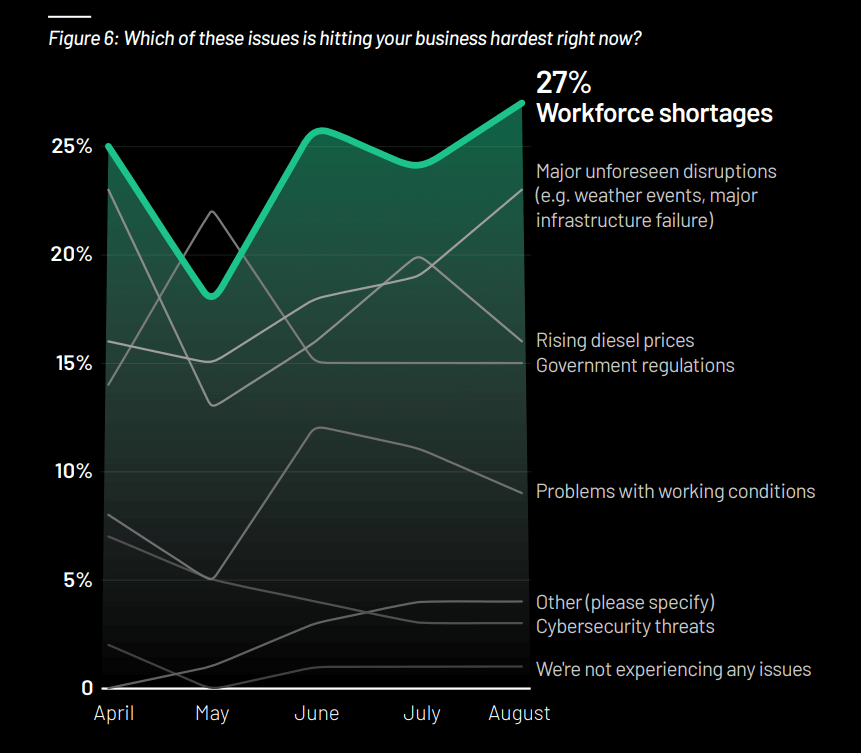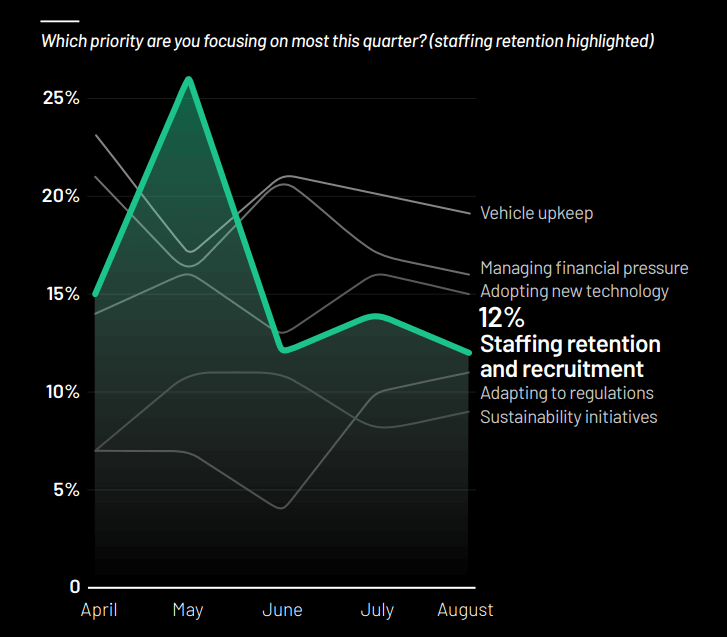What is one of the biggest challenges facing logistics companies today? Finding and retaining enough drivers to keep their fleets operating at full capacity.
Earlier this year, we found that the majority (63%) of freight businesses believe that driver recruitment and retention has stagnated or worsened since 2024.
Now, we have even more data about the impact of these critical shortages and how fleets are trying to address the problem. And some of these new insights might surprise you. Here’s what you need to know about our free report, The Workforce Crisis.
The Workforce Crisis 2025 Report: Key Takeaways
- Workforce shortages are a crucial issue for logistics companies, with between 18% and 27% of companies citing it as a major problem between April and August 2025.
- But for the last three surveyed months, companies that ranked “staffing retention and recruitment” as their top priority fell to fourth place, behind other concerns like vehicle upkeep and finances.
- 50% of fleets that have adopted applicant tracking software have 50 or more vehicles, potentially leaving smaller fleets to falter.
More Than a Quarter of Companies Faced Worker Shortages by August 2025
We’ve covered the ongoing trucker shortage plenty of times in the past. With the current trucker demographic continuing to age and few younger drivers choosing to enter the profession, it’s set to get worse for the foreseeable future.
Don’t just take our word for it, though: survey data from April to August 2025 found that workforce shortages were cited as a major problem by between 18% and 27% of logistics companies, and were nearly always at the top of their list of concerns.
In August alone, more than a quarter of respondents were dealing with these shortages – an amount 11% higher than those grappling with rising diesel prices.

Staffing Issues Continue in 2025
If you’ve worked in the logistics industry for any amount of time, you’ll know that recruitment is a hot-button topic, and one that constantly comes up. So, it is no surprise to see it come up as a major concern in Tech.co’s monthly survey, time and time again. However, what surprised me was that, while attracting new talent to the industry is seen as an ongoing battle, tackling it isn’t always a priority.

…But Few Companies Prioritize Staffing Retention
Logistics companies agree they have a workforce problem. But they aren’t doing enough to solve it.
Long-term strategies for attracting more workers, like training programs and improvements to working conditions, are tough to implement. Companies are facing more immediate concerns that demand more attention.
Across our most recent monthly surveys – June, July, and August – the amount of companies who ranked “staffing retention and recruitment” as their top priority consistently fell to fourth place, behind the higher numbers of companies who were focused on other problems, from vehicle upkeep to managing finances.
Large fleets are more likely to opt for pricey solutions like recruitment software. 50% of fleets that have adopted applicant tracking software have 50 or more vehicles, potentially leaving smaller fleets to falter (just 9% of those adopting this software have between one and four vehicles).

Tech.co: Who Are We and Where Did This Report Come From?
Tech.co is a global media brand with a focus on B2B technology. We cover a broad range of business technologies, from white collar solutions like website builders, project management tools, or CRM platforms, to blue collar tech solutions like field service, asset tracking, and fleet management.
For our most recent project — a series of seven reports covering the key dynamics of the logistics sector across most of 2025 so far — we opted for multi-faceted in-depth research that combined three core data sources.
First, we included the results from a pulse tracker survey we’ve been running every month since April 2025. Our 1,582 responses include logistics professionals, from ground-level staffers to senior management.
Second, we used our BenchmarkMe Survey data, which tracked 840 responses from purchase-decision makers discussing their technology priorities.
Finally, we conducted direct interviews with a selection of industry leaders, for added context.
Download our full report The Workforce Crisis here, to get a complete look at the valuable insights we found.
